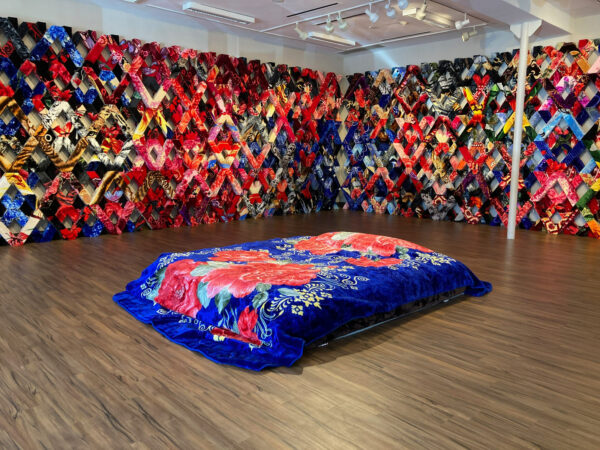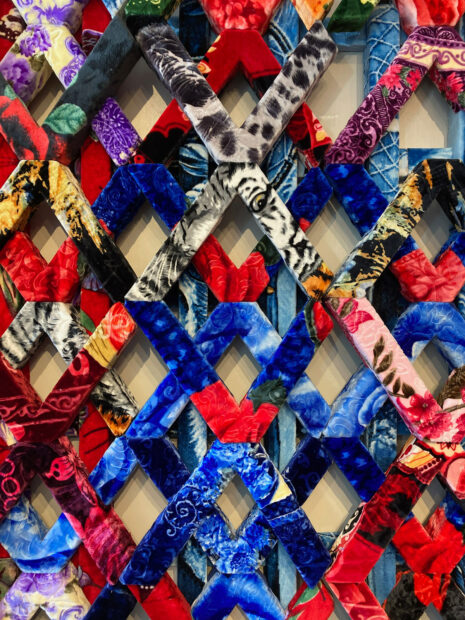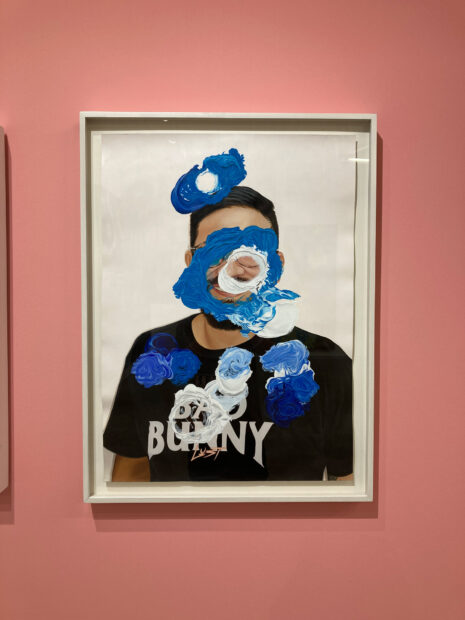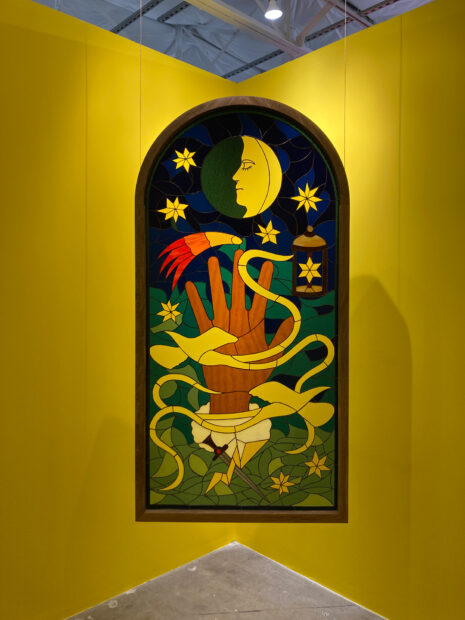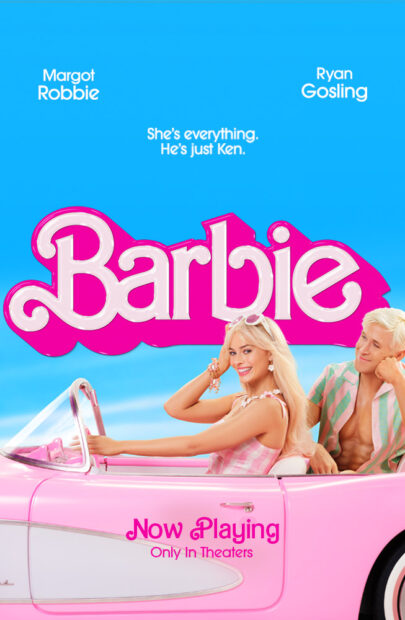Antonio Lechuga: Structures of Softness at the Oak Cliff Cultural Center, August 5 – September 2, 2023
Criss-crossed bars, resembling an “X” at the joint, and a four-pointed diamond in the negative space between them are the current motifs in Antonio Lechuga’s work. A similar body of work to what is on view here, titled Fences, was shown as freestanding pieces of lattice, covered in a fleece cobijas (artisan-made Mexican blankets weaved of acrylic and polyester) in a variety of colorful prints. Here, those lattices have been layered over each other to cover two long wall segments of the gallery. What appears to be a bed sits in the center of the space, until closer inspection reveals that it is layered sheets of the cobijas, arranged into a similar size and shape. The question occurs to me: is this a platform for a performance, or does it simply denote that the exhibition space is a bedroom? Lechuga’s fences are questioning what defines, divides, or unifies space.
****
Jammie Holmes: Make the Revolution Irresistible at the Modern Art Museum of Fort Worth, August 11, 2023 – November 26, 2023
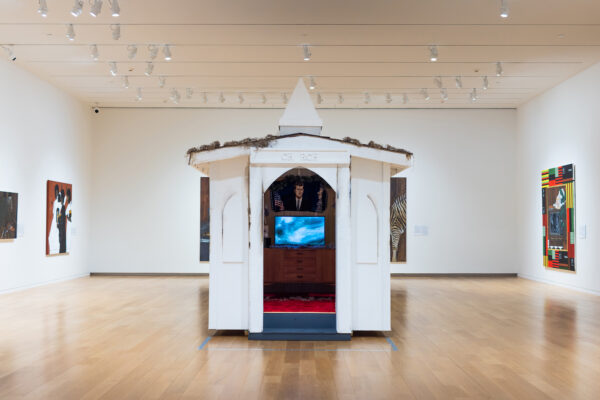
Jammie Holmes, “Church in the Wild” (installation view), 2023, painted wood, shingles; interior: acrylic paint, wood paneling, carpet, mid-century modern credenza, books, artificial plants, and color video with sound: 2 minutes, 29 seconds. Overall: 12 × 8 ½ × 11 feet. © Jammie Holmes. Courtesy of the Artist. Photo: Evie Marie Bishop
This exhibition is some of Jammie Holmes’ freshet work, as the vast majority of the paintings here were made in the current decade. The works are big, and museum curator María Elena Ortiz drew some lofty comparisons to Leonardo da Vinci’s The Last Supper during my visit, a distinction that requires some evidence, I think. The lack of contrast in these works surprised me, as I have become conditioned to expect strong pictorial and chromatic expression in painting. Make the Revolution Irresistible, in comparison, is not a flashy show. Holmes seems intent to root the world in a colorscape between brown and deep green, which asks the viewer to detect edges in subtle differences. There are flourishes here and there, by way of metallic confetti in gold and silver, or a stray pink smudge that attempts to frame a larger composition. A tiny chapel, wooden and painted white, streams fuzzy analog video from an old television in the center of the main gallery, with hardly enough room for two.
Holmes’s short career means that this exhibition, his first in a museum setting, is instructional for a local audience that has watched his career quickly balloon. (Holmes is based in Dallas.) We have been able to see him develop his bodies of work from their gestation. I had the opportunity to visit his studio last summer, and while many giant canvases were present then, I don’t recognize any of them here. Holmes is very busy.
My point is that his compositional acuity has grown in a compact time, and this is a somewhat uncommon opportunity to see a local artist coming into his prime while a museum shows work to his peers. It has been a short decade, but Holmes has been documenting it with vigor.
****
Adrienne Brown-David: Taken Aback by my Own Beauty: Identity as Rebellion at Pencil on Paper Gallery, July 8 – August 26, 2023
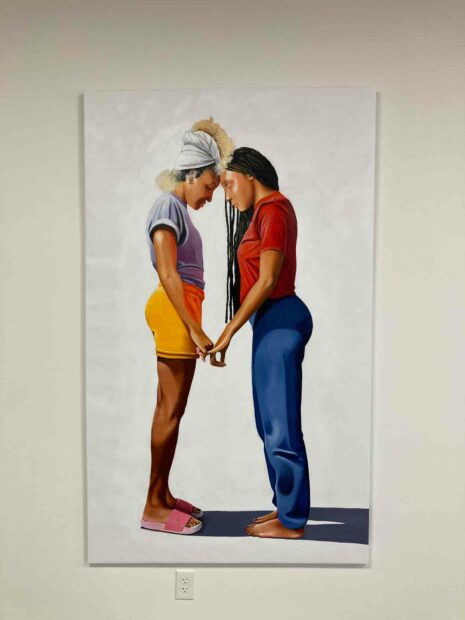
Adrienne Brown-David, “Taken Aback by my Own Beauty #20,” 2023, oil and acrylic on canvas, 47 × 80 inches
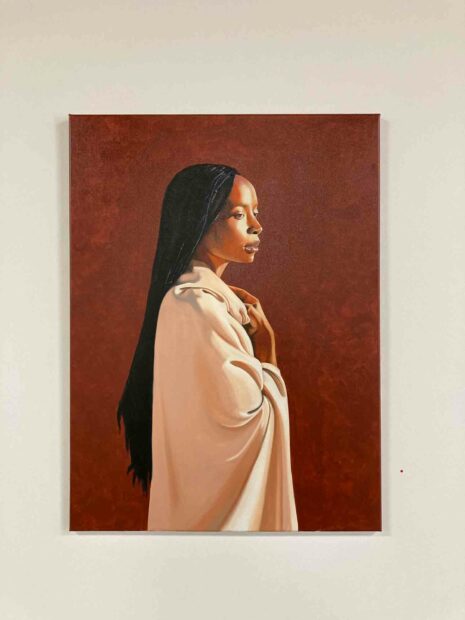
Adrienne Brown-David, “Taken Aback by my Own Beauty #8,” 2023, oil and acrylic on canvas, 30 × 40 inches
Pencil on Paper has mounted an exhibition of Black portraiture by Adrienne Brown-David, a resident of Missouri. The figures depicted here are friends and mostly family, with an overt tone of intimacy. Two of Brown-David’s four daughters are repeatedly shown, as in a painting where one of them is dressed differently for two different poses. Brown-David is focusing on self-expression of the individual, in an effort to encapsulate the dynamic nature of a family that is still taking shape. The background of each portrait is painted a distinct color after the figure has been completed, giving the work a reactive quality. Solo painting exhibitions of portraiture mean that the viewer may be sneaking a glimpse into intimate relationships, and there is always more of a story to tell than what we can see on the surface.
****
Eduardo Sarabia: this must be the place at Dallas Contemporary, April 20 – September 24, 2023
When paired with Dallas Contemporary’s concurrent exhibition, cerámica suro: a story of collaboration, production, and collecting in the contemporary arts, Eduardo Sarabia’s work feels contextualized, at least in the sense of the plasticity of the material he’s using. This incredibly dense show (see: the labyrinthine gallery map provided outside the gallery’s entrance) is laid out as a Mexican hacienda, and its rooms are labeled as domestic spaces.
The way Sarabia’s differing bodies of work fill out the space makes the installation feel as though it could be studied for a few hours. There are ceramic tiles, as well as blue and white vessels, which are both decorated in a chinoiserie style, featuring alluring swimsuit models and other chicano figures. Once, on a research expedition, Sarabia encountered a drug cartel member in Sinaloa, Mexico. As they spoke, the artist designed a fountain based on the cartel member’s description of a sculpture commission he wished to make. Sarabia then went back to Cerámica Suro and created the piece. This exhibition’s re-imagining of Mexican elements and style, combined with a distinctly melting pot approach to culture, makes this show a highlight of the summer.
****
Barbie, Directed by Greta Gerwig, 2023
Barbie Land, the fantasy world in Greta Gerwig’s film adaptation of the Mattel toy, is not dissimilar to the Christian concept of heaven. All of its inhabitants spend every day in perpetuity repeating utopic bliss and wear fabulous glowing robes. Perhaps the main difference is that in Barbie Land, society is ordained by women. Men are present and liked, but at times are vocally regarded as superfluous. I may also point out that every physical attribute of this magenta universe is skeuomorphic, which means that appearances only refer to hypothetical functions. The shower does not run water, and the waves of the ocean are literally plastic; they are fixed in time and space.
I entered the theater with some basic assumptions about the film: that it would have a strong feminist message, and that it would be almost uniformly pink. It is difficult not to form an opinion of Barbie prior to seeing it, as its marketing campaign lasted nearly one calendar year before release and included over 100 promotional partners. The more attention and popular zeitgeist it generated, the more I assumed it would be a very conventional media product, at least ideologically. I was looking for it when I attended a screening of the film in Pittsfield, Massachusetts. “This theater is never this well attended,” my host, RJ Supa, told me. There must be something in the water.
An immediate lesson I learned from my viewing experience was to hold off expectations about a film, even if its mission is to be a vehicle for merchandise (Barbie is, firstly, a toy). Gerwig and Noah Baumbach, who co-wrote the screenplay, have managed to wring out insight from the American doll brand. Barbie’s perfect environment creates a vacuum of meaning in her relationship with Ken, which is the internal conflict of the film. This is performed with charisma on the part of Ken (Ryan Gosling), and open-minded introspection from Barbie (Margot Robbie).
The cinematic experience suffers somewhat from an excess of clarity, by way of the digital cinematography. There can be a flatness of presentation, as in scenes that happen at the dream houses or in the Mattel top-level boardrooms. Other scenes, like a fight in the Barbie Land dream world, feel more dynamic, with greater depth of field and a complex sense of time. Musical numbers advance the story, but also refer to the decades of American film musicals in their set design and choreography.
Finally, I do appreciate the film’s moral: that supremacy is a condition for which all beings must make amends. I’ll be more specific: Barbie says that patriarchy makes men into tyrants, and it really doesn’t have to be that way. The conceit operating the film (that Barbies are a kind of idealized projection of the people that play with them) forces some awkward literalism, which requires that there must be a one-to-one representation between what exists in the fantasy universe of the film and what the movie calls “the real world.” In general, I found Barbie to offer some creative surprises in spite of all the commerce from which it came.
William Sarradet is the Assistant Editor for Glasstire.


